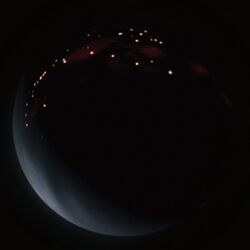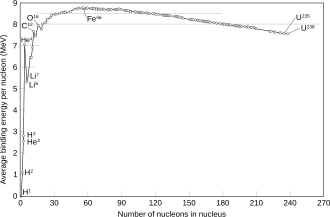Assisted Planetary Fusion Ignition (A1-0): Difference between revisions
No edit summary Tag: 2017 source edit |
|||
| Line 6: | Line 6: | ||
== Mechanism == | == Mechanism == | ||
[[File:Binding energy curve - common isotopes.svg|left|thumb|300x300px]] | [[File:Binding energy curve - common isotopes.svg|left|thumb|300x300px|Binding energy for different atom nuclei.]] | ||
Nuclear fusion produces when two atoms nuclei get close enough for enough time for the nuclear force that pushes them together surpasses the electrostatic forces keeping them together, resulting in them fusing into heavier nuclei. Due to hydrogen having the lightest atom of them all, consisting of a single proton, it's the easiest element to fuse, and has the highest energy output attainable. | Nuclear fusion produces when two atoms nuclei get close enough for enough time for the nuclear force that pushes them together surpasses the electrostatic forces keeping them together, resulting in them fusing into heavier nuclei. Due to hydrogen having the lightest atom of them all, consisting of a single proton, it's the easiest element to fuse, and has the highest energy output attainable. | ||
| Line 16: | Line 16: | ||
=== Localized === | === Localized === | ||
[[File:APFI principle.png|thumb|462x462px|Assisted Planetary Fusion Ignition principle.]] | |||
It's the most simple and primitive way of assisted ignition. It doesn't use any pre-established infrastructure, and it has the lowest power output out of them. This procedure starts by finding a suitable Jovian planet to start orbiting. After entering low orbit, a single nuclear weapon is dropped into the atmosphere of the Jovian planet, which then is detonated deep into the planet. The fission fuel ignites, pushing against the surrounding hydrogen and helium around it. This, in turn, starts a fusion reaction that pushes against the fission fuel, concentrating the material and powering further fission. Likewise, this fusion reaction pushes against the atmosphere surrounding it, further fusing atoms. | It's the most simple and primitive way of assisted ignition. It doesn't use any pre-established infrastructure, and it has the lowest power output out of them. This procedure starts by finding a suitable Jovian planet to start orbiting. After entering low orbit, a single nuclear weapon is dropped into the atmosphere of the Jovian planet, which then is detonated deep into the planet. The fission fuel ignites, pushing against the surrounding hydrogen and helium around it. This, in turn, starts a fusion reaction that pushes against the fission fuel, concentrating the material and powering further fission. Likewise, this fusion reaction pushes against the atmosphere surrounding it, further fusing atoms. | ||
The resulting energy from this is then recollected by the ship with solar panels in the form of light and radiation. | The resulting energy from this is then recollected by the ship with solar panels in the form of light and radiation. | ||
Revision as of 18:20, 6 August 2023

Assisted Planetary Fusion Ignition, or APFI, is the process in which a Jovian or celestial body composed mainly of hydrogen and helium, but which does not meet the mass criteria for sustained nuclear fusion, is ignited artificially through the use of low yield nuclear weapons, prompting short-lived fusion reactions within its atmosphere.
This is a rather primitive technology used for the obtention of energy from gas bodies without the use of stellification engines, typically employed by civilizations lower than the S1 level.
Mechanism

Nuclear fusion produces when two atoms nuclei get close enough for enough time for the nuclear force that pushes them together surpasses the electrostatic forces keeping them together, resulting in them fusing into heavier nuclei. Due to hydrogen having the lightest atom of them all, consisting of a single proton, it's the easiest element to fuse, and has the highest energy output attainable.
The electrostatic force that keeps the nuclei apart has a longer range than the strong force, which has the range equivalent to the diameter of a proton. This results in the atoms needing a set quantity of kinetic energy to approach close enough for the strong force to take a toll and for the nuclei to fuse. This energy requirement is known as the "Coulomb barrier", which can be broken by heating up the atoms enough, or accelerating them enough in a particle accelerator, which effectively provides the nuclei with the kinetic energy required.
Methods
The different methods of Assisted Planetary Fusion Ignition are characterized by the level of energy inputted in the system for a higher energy output.
Localized

It's the most simple and primitive way of assisted ignition. It doesn't use any pre-established infrastructure, and it has the lowest power output out of them. This procedure starts by finding a suitable Jovian planet to start orbiting. After entering low orbit, a single nuclear weapon is dropped into the atmosphere of the Jovian planet, which then is detonated deep into the planet. The fission fuel ignites, pushing against the surrounding hydrogen and helium around it. This, in turn, starts a fusion reaction that pushes against the fission fuel, concentrating the material and powering further fission. Likewise, this fusion reaction pushes against the atmosphere surrounding it, further fusing atoms.
The resulting energy from this is then recollected by the ship with solar panels in the form of light and radiation.